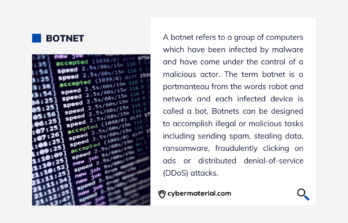
A botnet refers to a group of computers which have been infected by malware and have come under the control of a malicious actor. The term botnet is a portmanteau from the words robot and network and each infected device is called a bot.
Botnets can be designed to accomplish illegal or malicious tasks including sending spam, stealing data, ransomware, fraudulently clicking on ads or distributed denial-of-service (DDoS) attacks.
Botnets are commonly used for nefarious purposes, such as:
Distributed Denial of Service (DDoS) attacks: Botnets can be utilized to launch large-scale DDoS attacks, where multiple bots simultaneously flood a target website or network with an overwhelming amount of traffic, causing it to become inaccessible.
Spam campaigns: Botnets can be used to send out massive volumes of spam emails, promoting scams, phishing attempts, or distributing malware.
Click fraud: Botnets can generate fake clicks on online advertisements, leading to financial losses for advertisers.
Information theft: Bots can be programmed to harvest sensitive information, such as login credentials, credit card details, or personal data, from infected devices.
Cryptocurrency mining: Botnets may be employed to hijack the computing power of infected devices to mine cryptocurrencies, allowing the botmaster to profit at the expense of the device owners.
Preventing and mitigating botnet attacks can be challenging due to their distributed nature and the constantly evolving tactics employed by botmasters. Effective measures include keeping devices and software up to date with security patches, using reputable antivirus software, employing strong and unique passwords, being cautious with email attachments and suspicious links, and implementing network traffic monitoring and filtering.
Additionally, cooperation between law enforcement agencies, internet service providers, and cybersecurity organizations is crucial in identifying and dismantling botnets.
The post What’s a Botnet and how does it work? first appeared on CyberMaterial.


